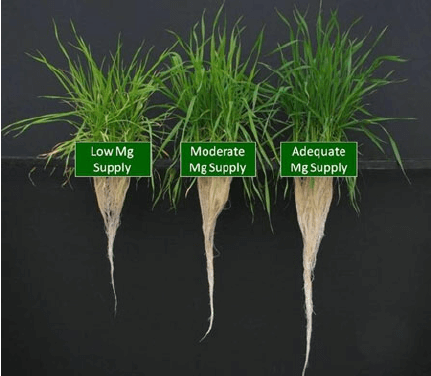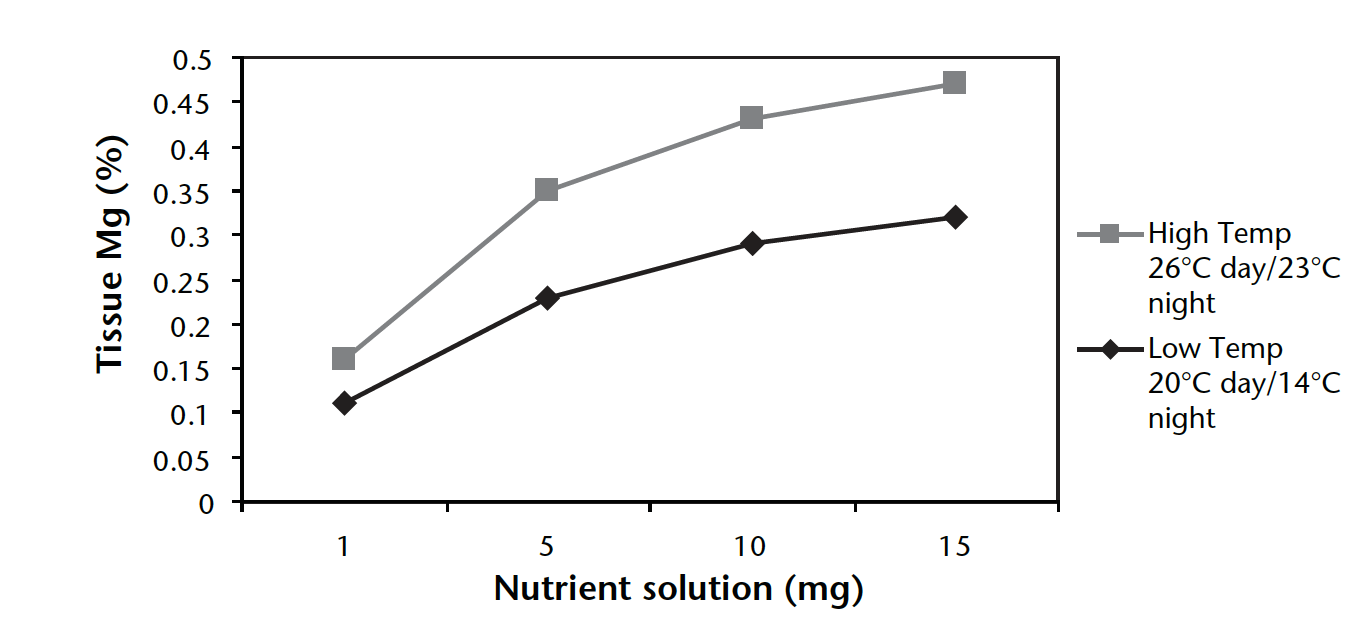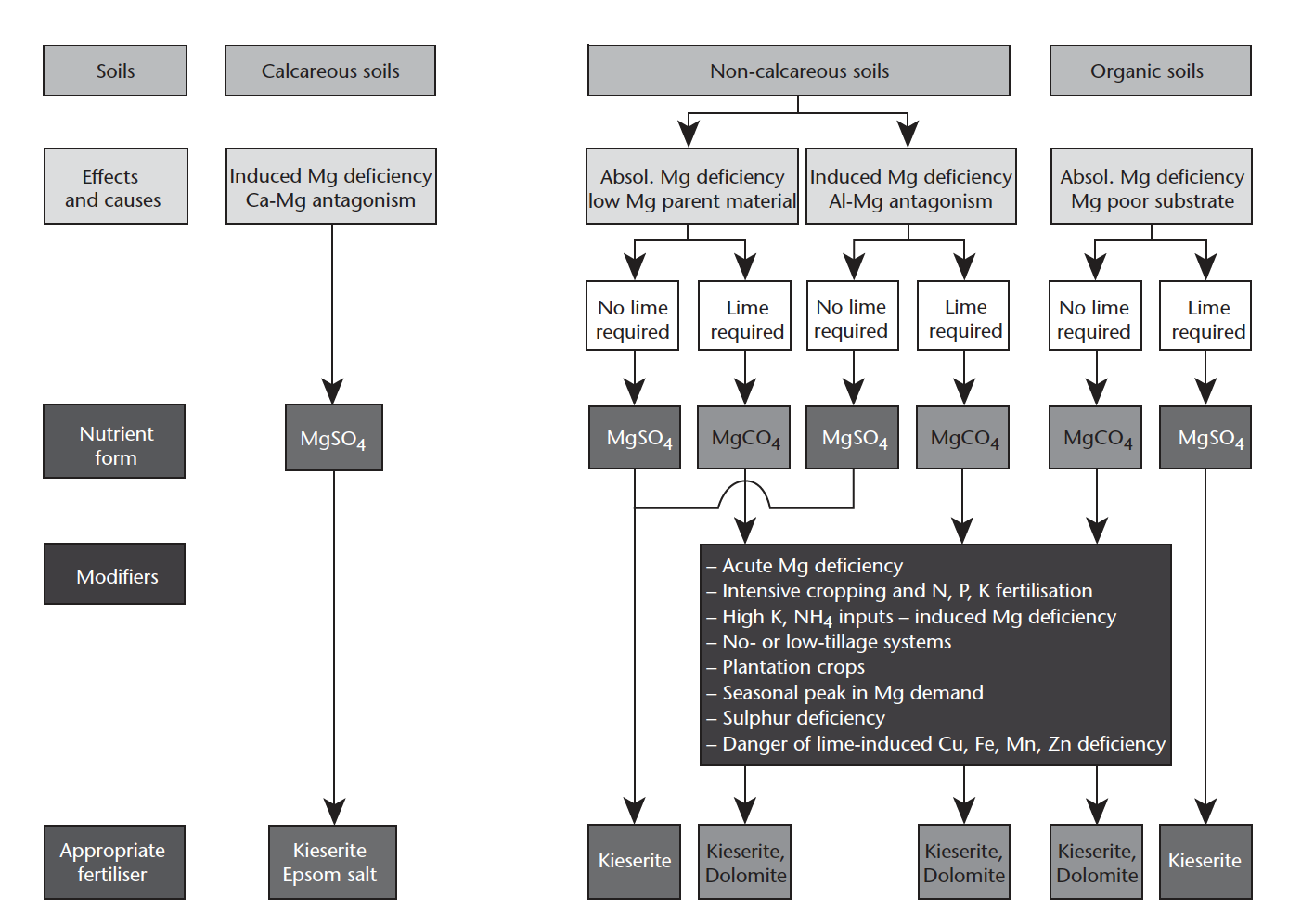Magnesium Fertilizers.
Magnesium is commonly in use as a turf fertilizer, with kieserite fertilizer, magnesium sulphate fertilizer or magnesium oxide used to manage magnesium deficiency in plants. But are these the best options to address any magnesium deficiency in plants, and how do you know what is the best magnesium fertilizer to use?
The form in which you use Mg fertilizers has a big effect on their tank compatibility, and the results you get in any fertilizer strategy.
Chlorophyll is a light-absorbing pigment that absorbs blue and red light waves and reflects green light waves. This pigment is what gives plants their green colour.
Magnesium is the central atom of chlorophyll, and only a fraction of the total magnesium is bound to chlorophyll (around 25%). About 70% is relatively mobile, and present in plant sap. The magnesium ion is also involved in many enzyme reactions and in protein synthesis.
Symptoms of Magnesium deficiency in plants.
The main symptom of magnesium deficiency in plants is interveinal chlorosis. Interveinal chlorosis, is when there is yellowing between the leaf veins, sometimes with a reddish-brown colour. The veins themselves remain green.
The key to identifying if you have a magnesium deficiency, is the location of this chlorosis, as it can become confused with iron deficiency.
As magnesium is highly mobile in the plant, the first signs of magnesium deficiency appear on the older, lower leaves as magnesium moves towards new growth.
Magnesium deficiency in turfgrass.
Soil cations such as ammonium, potassium, and calcium and a low soil pH all reduce magnesium uptake.
Heavy liming and calcium or potassium fertilizer applications, without any additional magnesium, will cause a magnesium deficiency. This “induced” deficiency, is seldom considered when applying potassium fertilizers.
Additionally irrigating turfgrass can result in magnesium leaching out of the root zone, which is likely in sandy soils.
Low levels of magnesium cause a reduction in the root: shoot ratio (weight of roots/weight of shoots)1Cakmak I, Magnesium in Crop Production, Food Quality and Human Health. 2013. Plant and Soil 368(1-2) DOI:10.1007/s11104-013-1781-2. This reduction in root: shoot ratio can be less than half that of a plant low in magnesium, and the resulting poor root system can impact turfgrass wear tolerance.

Soil type.
Both soil texture and soil organic matter influence magnesium availability. The actual type of clay present also has an influence, as although the soil may contain similar clay content, magnesium availability can vary.
Soils containing a high content of kaolinitic clay, that are sandy and have a low organic matter content require more frequent magnesium fertilization. This contrasts with heavy soils and those with a high CEC, which generally require larger and less frequent applications.

Figure showing how temperature effects Magnesium tissue content
When does it occur?
The following conditions inhibit magnesium uptake:
- Excess irrigation or heavy rainfall.
- Sandy and low CEC soils.
- After liming.
- Acidic (low pH) soil. Low soil pH soils lock up magnesium by reducing magnesium solubility. This makes it less available
- Applications of high potassium fertilizer.
- Cold and wet weather.
When to apply a magnesium fertilizer:
- Soil magnesium levels are low;
- The soil pH is high, or you use lime;
- You use ammonium nitrogen leads to antagonism between ammonium and magnesium;
- Compaction exists, and finally
- A spell of wet/cold weather leads to low magnesium soil mobility.
Common Magnesium fertilizers.
When deciding on which magnesium fertilizer to use you must be aware of their specific characteristics. These can be quick-release soluble salts such as magnesium sulphate fertilizer and magnesium nitrate or slow-release forms like magnesium oxide.
Quick-release types:
- Magnesium sulphate fertilizer, in the form of Epsom salts (10% magnesium) and magnesium nitrate (11% magnesium).
Medium-release:
- Kieserite fertilizer (16% magnesium).
- Calcium Magnesium carbonate, known as dolomitic lime, contains 3–12% magnesium, and Granomag® which is magnesium oxide, contains 57% magnesium.
So why use Kieserite Fertilizer?
- It produces a consistent supply of magnesium.
- The release pattern of kieserite fertilizer corresponds well with turf demand.
- As kieserite moves down the soil profile, it optimizes uptake and lastly,
- It is user-friendly, and you can use it as a granular or a fine powder.
Epsom salts contain 10% magnesium and are also known as magnesium sulphate fertilizer. It is highly soluble and prevents and corrects any magnesium deficiency in plants. However, due to its high solubility, it will leach, especially on sandy soils.
Granomag contains 57% magnesium as magnesium oxide and is often found in fertilizer blends. However, it is insoluble and not readily available to the turf as it takes so long to break down. The other disadvantage is that due to its large particle size, it is not suitable for use on closely cut turf, such as greens, unless during renovation after hollow tine aeration.
Magnesium nitrate contains 10% nitrogen and 11% magnesium. A foliar application of magnesium nitrate is an ideal way to deliver magnesium and nitrate-nitrogen. Consequently, you can reduce rates by 30–50% in comparison to Epsom salts (magnesium sulphate). As it is sulphate-free, it also does not have issues with tank compatibility. However, due to its high solubility this will leach rapidly out of sandy soils.
A simple method for identifying the correct fertilizer type for a given soil type and condition (courtesy BASF).
References

Jerry Spencer
Graduated from Newcastle University with an Hons Degree in Soil Science in 1988, Jerry then worked for the Sports Turf Research Institute (STRI) as a turf agronomist before emigrating to Australia in 1993.
He followed this by gaining a Grad Dip in Business Management from UTS. He has worked in a number of management roles for companies as diverse as Samsung Australia, Arthur Yates and Paton Fertilizers.
He has always had a strong affinity with the Australian sports turf industry and as a result he established Gilba Solutions as an independent sports turf consultancy in 1993. Jerry has written over 100 articles and two books on a wide range of topics such as Turf Pesticides and Nutrition which have been published in Australia and overseas.



